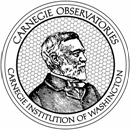
- Home
- Quick Facts
- Exposure Calculator
- Calibration
- Manual & Documents
- About Us
- Optics
- Mechanical
- Electronics
- Software
- Pictures
- Calendar
- Status
Technical Staff Links
Optical DesignFour Star will reside on the Magellan-Baade Nasmyth platform. A refractive optical system was chosen with all elements except the front window/lens being cooled to cryogenic temperatures and in a vacuum. |
| The Four Star optics were designed by Carnegie Staff member Stephen Schectman who also provided a similar refractive design for the PANIC IR camera. This optical design may be classified as a seven element design with three groups. The first group is a pair of field lenses which serve as a type of collimator to reconverge the beam. This group consists of two 16" diameter fused silica field lenses (L1, L2) which form an exit pupil just in front of element L3, reducing the beam waist and providing a useful location for a cold pupil stop. Element L1 also serves as a vacuum window. A cold stop is placed at the exit pupil. This cold stop blocks most stray thermal radiation from striking the detector. Elements L3, L4, L5, and L6 form the second group which we refer to as the Camera Module. The Camera Module essentially reconverges the f/11 telescope beam to f/3.6 at the focal plane. Just before the focal plane the third group, consisting of a field flattener and filter performs additional aberration correction, field flattening, and filtering. There are three field flattener lenses, one for each broadband IR filter. This allows optimal aberration correction and optimal coating effectiveness near the focal plane. The final plate scale delivered by the f/3.6 beam is 0.16"/pixel accommodating an effective areal coverage of 10.8' x 10.8'. |
| The Four Star lenses are all spherical except for L3 which is a CaF2 element with an aspherical surface front surface. The instrument will be deployed with three field flattener lenses covering the J,H, and Ks bands. There are two filter wheels, accommodating ten filters total. FourStar will be deployed with broadband J,H, Ks filters and a set of medium-band filters that subdivide the J and H bands. |

Carnegie Observatories, 813 Santa Barbara Street, Pasadena, California, 91101 USA
©Trustees of the Carnegie Institution of Washington
These Documentation pages are Design in Progress and content may change. Last updated: March 13, 2010
The Carnegie Observatories | Las Campanas Observatories | Contact Us